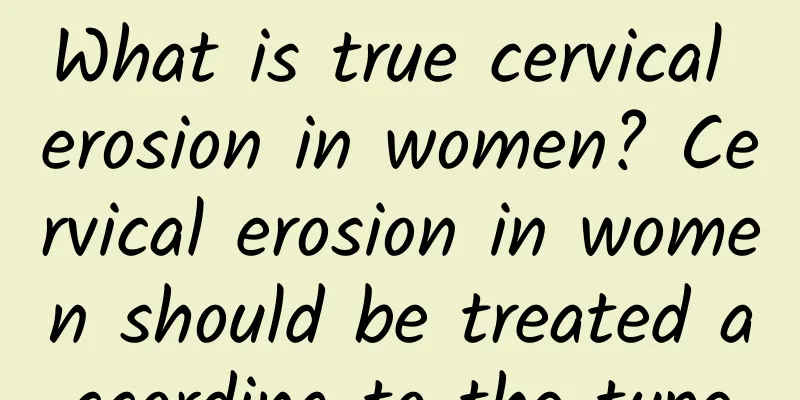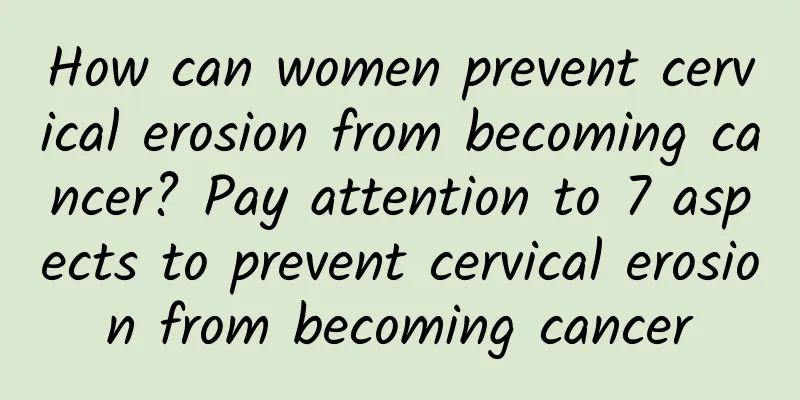What is true cervical erosion in women? Cervical erosion in women should be treated according to the type

|
There are true and false cervical erosion. It is very important to make a detailed diagnosis and identification of cervical erosion in clinical practice. Only with correct differential diagnosis can we get the correct treatment and avoid misdiagnosis, delaying treatment or over-treatment. How to distinguish true and false cervical erosion in women? What are the types of true cervical erosion and the corresponding symptoms? Only after the doctor's diagnosis and examination and symptomatic treatment can the patient recover a healthy body as soon as possible. What is true cervical erosion True cervical erosion is caused by the fact that the surface of the cervix is often covered with a lot of mucus or purulent secretions. These secretions stimulate and soak the squamous epithelium around the external os of the cervix for a long time. In addition, the inflammatory infiltration of the deep tissue of the cervix causes the squamous epithelium covering the surface of the cervix to lose its vitality and fall off, forming ulcers. This is true erosion. This erosion surface is quickly covered by the surrounding columnar epithelium, forming a red area with a granular surface and a certain luster, that is, pseudo-erosion. The cervical erosions we find in our daily work are mostly pseudo-erosions, while true erosions are only a short stage in the process of this pathological process, and its prognosis will be that the surface is covered by columnar epithelium and becomes pseudo-erosion. The difference between true cervical erosion and pseudo-cervical erosion is that it is not a physiological natural phenomenon, it will worsen the pathological changes, and the harm is also greater. Symptoms of true cervical erosion Mild cervical erosion: The erosion area is less than 1/3 of the entire cervical area; patients generally do not have any discomfort symptoms, and may only have increased vaginal discharge, which can be easily overlooked. Moderate cervical erosion: The eroded area accounts for 1/3-2/3 of the entire cervical area; the main symptom is increased vaginal discharge, which is milky white mucus or light yellow purulent fluid. When accompanied by cervical polyps, there is a tendency for bloody leucorrhea or bleeding after sexual intercourse. Severe cervical erosion: The eroded area reaches more than 2/3 of the entire cervical area. It causes pain in the lower abdomen or lumbosacral region, accompanied by a feeling of falling. When the inflammation is severe, it can spread along the uterosacral ligament and cardinal ligament to cause pelvic connective tissue inflammation. What are the types of cervical erosion? (1) Pseudo-erosion The pathological concept of erosion refers to "shedding of the surface epithelium", and the cervical erosion commonly seen in clinical work is mostly the red area around the external os of the cervix. During colposcopy, after applying 3% acetic acid on the surface of the red area, it can be seen that the red area is partially changed into a "grape bunch", which is caused by columnar epithelial edema. If a biopsy is performed on this area, columnar epithelium can be seen on the surface under a microscope. Therefore, if the pathological definition of erosion is strictly followed, this area does not belong to erosion, so some people suggest calling it pseudo-erosion. Most cervical erosions seen in clinical work belong to this type. (2) True erosion True erosions vary greatly in appearance depending on the severity of the lesion. In clinical work, the type of erosion in which the columnar epithelium on the surface of the cervix grows slowly and is only covered by a relatively normal single layer of columnar epithelium, with a flat appearance, flushed and smooth surface, is often called simple erosion. If the columnar epithelium grows quickly and grows toward the stroma, glandular hyperplasia and expansion will form, and the surface will appear as fine particles to the naked eye, which is called granular erosion or follicular erosion. If the stroma hyperplasia is obvious, many small protrusions or grooves will form on the surface of the cervix, and the surface will appear uneven to the naked eye. This type of erosion is called papillary erosion. What other types of cervical erosion are there? (3) Congenital erosion During fetal development, except for the vaginal epithelium, all other reproductive tract epithelia originate from the coelomic epithelium. When the embryo develops to the third or fourth month, the cylindrical epithelium in the cervical canal and the squamous epithelium on the surface of the cervical vagina can be clearly distinguished. At this time, the junction of the two types of epithelium is not at the cervical os, but in the cervical canal. When the embryo develops to the sixth or seventh month, the columnar epithelium of the cervix has acquired the secretory function. In the late pregnancy, these columnar epithelia are affected by maternal estrogen, and the columnar epithelium of the cervical mucosa proliferates and begins to grow outward from the cervical os and surpasses the external cervical os. Therefore, about 1/3 of the cervix of newborn girls has cervical erosion similar to that of adults. Since there are no factors such as lacerations and infections that cause cervical erosion at this time, this erosion is called congenital erosion. After birth, the influence of maternal estrogen gradually subsides, and this erosion of newborn girls also subsides on its own. (4) Acquired erosion Acquired erosion is in contrast to congenital erosion. It mostly occurs in women of childbearing age with vigorous ovarian function. The columnar epithelium of the cervical canal is affected by the estrogen produced by the ovaries and overproliferates, exceeding the external cervical os, making the external cervical os eroded. The appearance of this erosion is no different from that caused by inflammation, but the cause of the erosion is different. This erosion is more common during pregnancy, and most of them can disappear on their own after delivery. Due to different causes, the clinical manifestations are somewhat different. Such patients will also have more leucorrhea, but the nature of the leucorrhea is clear and mucous, tightly attached to the surface of the cervix, and not easy to wipe off. During pathological examination, there is no inflammatory cell infiltration under the columnar epithelial cells, but there is glandular and interstitial hyperplasia. This shows that this erosion may be related to endocrine changes, but it seems to have no direct relationship with inflammation. Of course, it is easy to develop secondary inflammatory infection on the basis of erosion, but this inflammatory manifestation is only the result, not the cause of erosion. Warm reminder: If true cervical erosion is not treated in time or not treated at all, it will often endanger women's health and may cause female infertility; it will lead to female endometritis and chronic pelvic inflammatory disease, and long-term inflammatory stimulation can cause deeper lesions such as polyps, eversion, cysts, etc., and it will also increase the risk of women suffering from cervical cancer. Therefore, early and active treatment is very important. |
Recommend
What are the common precautions after abortion?
With the development of society, people have beco...
How harmful is cervical erosion?
Cervical erosion is a common gynecological diseas...
What are the sequelae of microwave treatment for female cervical erosion? Three points to note when microwave treatment for female cervical erosion
Most women have some gynecological diseases, amon...
What foods should not be eaten when you have uterine fibroids? Four types of foods that women with uterine fibroids should not eat
1. Hot foods Due to the special physiological cha...
What can we do to prevent childhood obesity? Nutritionist's advice...
According to the survey, the number of overweight...
【Video】4 Reasons Why You Must Eat Fascinating Fermented Foods!
On the tables of Europeans and Americans, "c...
What should I do if I have uterine fibroids? What is the treatment for uterine fibroids?
The treatment of uterine fibroids is generally ba...
Patients with cervical hypertrophy should be aware of its common symptoms in advance
Nowadays, more and more women may suffer from cer...
What is the cause of ovarian cyst pain? What should I pay attention to after surgery?
The incidence of ovarian cysts is very high, they...
Out-of-control liver index, liver protection drugs are ineffective! The medical examiner did it by losing 6 kilograms!
What should I do if my liver function index (GPT ...
To prevent vaginitis in summer, you should pay attention to the following points
Summer is the peak season for vaginitis, but how ...
Imbalanced pH in the body can easily lead to vaginitis
The imbalance of pH in women's bodies creates...
Treatment of gynecological diseases pelvic inflammatory disease affects life expectancy
Pelvic inflammatory disease is very harmful. Some...
Which hospital treats female cervical warts
With the continuous development of society and th...
What is the difference between implantation bleeding and menstruation?
Of course, there are still big differences betwee...









